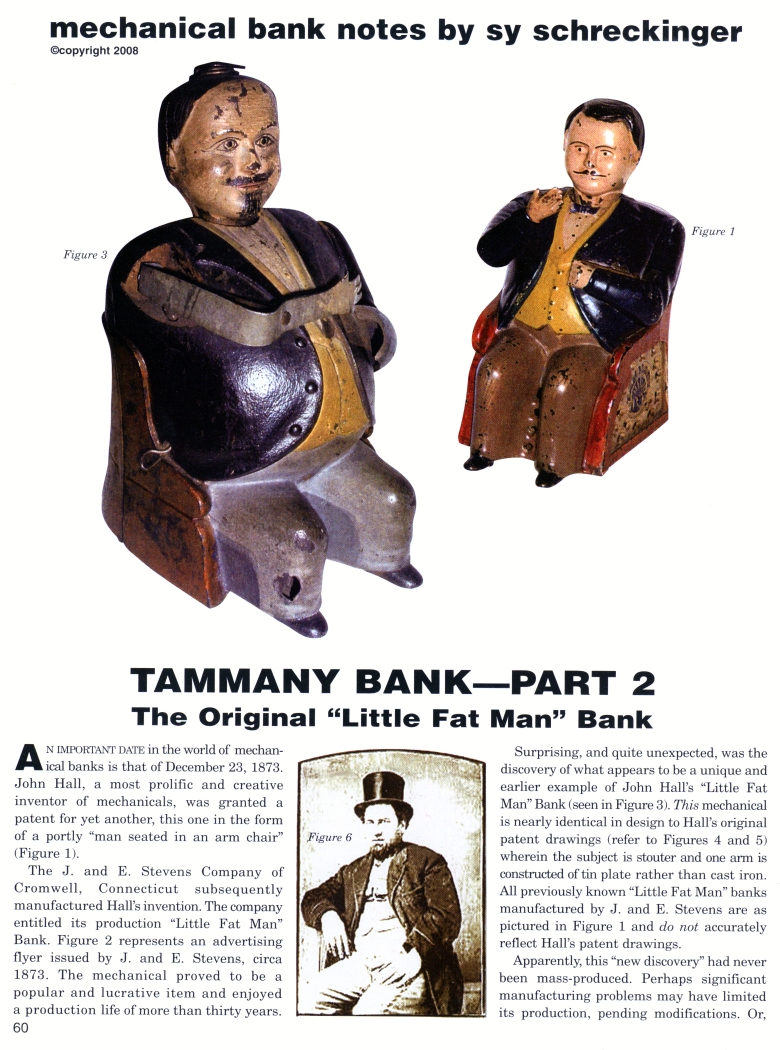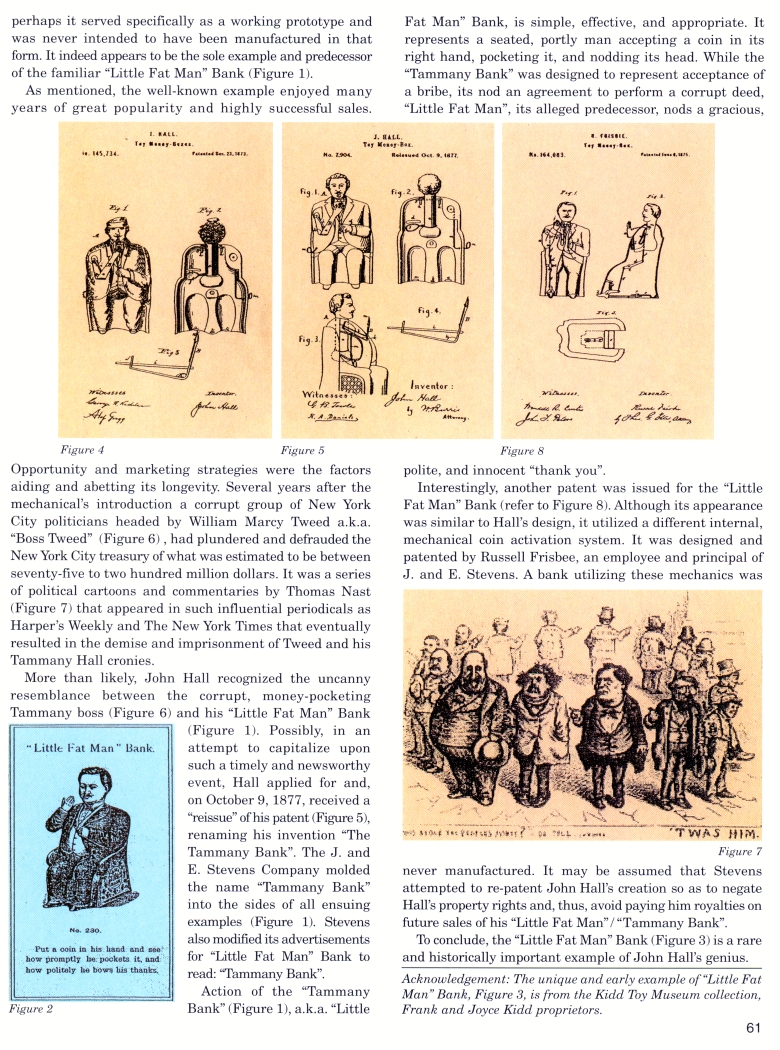|
Tammany Bank — Part 2
The Original “Little Fat Man” Bank
by Sy Schreckinger – ANTIQUE TOY WORLD Magazine – April, 2008
An important date in the world of mechanical
banks is that of December 23, 1873. John Hall, a most prolific and
creative inventor of mechanicals, was granted a patent for yet another,
this one in the form of a portly "man seated in an arm chair" (Figure 1).
The J. and E. Stevens Company of Cromwell, Connecticut subsequently
manufactured Hall's invention. The company entitled its production "Little
Fat Man" Bank. Figure 2 represents an advertising flyer issued by J. and
E. Stevens, circa 1873. The mechanical proved to be a popular and
lucrative item and enjoyed a production life of more than thirty years.
Surprising, and quite unexpected, was the discovery of what appears
to be a unique and earlier example of John Hall's "Little Fat Man" Bank
(seen in Figure 3). This mechanical is nearly identical in design to
Hall's original patent drawings (refer to Figures 4 and 5) wherein the
subject is stouter and one arm is constructed of tin plate rather than
cast iron. All previously known "Little Fat Man" banks manufactured by J.
and E. Stevens are as pictured in Figure 1 and do not accurately reflect
Hall's patent drawings.
Apparently, this "new discovery" had never been mass-produced.
Perhaps significant manufacturing problems may have limited its
production, pending modifications. Or, perhaps it served specifically as a
working prototype and was never intended to have been manufactured in that
form. It indeed appears to be the sole example and predecessor of the
familiar "Little Fat Man" Bank (Figure 1).
As mentioned, the well-known example enjoyed many years of great
popularity and highly successful sales. Opportunity and marketing
strategies were the factors aiding and abetting its longevity. Several
years after the mechanical's introduction a corrupt group of New York City
politicians headed by William Marcy Tweed a.k.a. "Boss Tweed" (Figure 6) ,
had plundered and defrauded the New York City treasury of what was
estimated to be between seventy-five to two hundred million dollars. It
was a series of political cartoons and commentaries by Thomas Nast (Figure
7) that appeared in such influential periodicals as Harper's Weekly and
The New York Times that eventually resulted in the demise and imprisonment
of Tweed and his Tammany Hall cronies.
More than likely, John Hall recognized the uncanny resemblance
between the corrupt, money-pocketing Tammany boss (Figure 6) and his
"Little Fat Man" Bank (Figure 1). Possibly, in an attempt to capitalize
upon such a timely and newsworthy event, Hall applied for and, on October
9, 1877, received a "reissue" of his patent (Figure 5), renaming his
invention "The Tammany Bank". The J. and
E. Stevens Company molded the name "Tammany Bank" into the sides of all
ensuing examples (Figure 1). Stevens also modified its advertisements
for "Little Fat Man" Bank to read: "Tammany Bank".
Action of the "Tammany Bank" (Figure 1), a.k.a. "Little Fat Man"
Bank, is simple, effective, and appropriate. It represents a seated,
portly man accepting a coin in its right hand, pocketing it, and nodding
its head. While the "Tammany Bank" was designed to represent acceptance of
a bribe, its nod an agreement to perform a corrupt deed, "Little Fat Man",
its alleged predecessor, nods a gracious,
polite, and innocent "thank you".
Interestingly, another patent was issued for the "Little Fat Man"
Bank (refer to Figure 8). Although its appearance was similar to Hall's
design, it utilized a different internal, mechanical coin activation
system. It was designed and patented by Russell Frisbee, an employee and
principal of J. and E. Stevens. A bank utilizing these mechanics was never
manufactured. It may be assumed that Stevens attempted to re-patent John
Hall's creation so as to negate Hall's property rights and, thus, avoid
paying him royalties on future sales of his "Little Fat Man"/"Tammany
Bank".
To conclude, the "Little Fat Man" Bank (Figure 3) is a rare and
historically important example of John Hall's genius.
Acknowledgement: The unique and early example of "Little Fat Man"
Bank, Figure 3, is from the Kidd Toy Museum collection, Frank and Joyce
Kidd proprietors.
|


